Apple's iPhone 4: Thoroughly Reviewed
by Brian Klug & Anand Lal Shimpi on June 30, 2010 4:06 AM EST- Posted in
- Smartphones
- Apple
- iPhone 4
- Gadgets
- Mobile
Screen - Retina Display
Right out of the box, the iPhone 4's new 326 PPI, 960x640, 3.5" display is arguably the single most striking change the new iPhone brings. In a word, it's dazzling. Text and high res images look amazingly sharp on the iPhone 4’s retina display. It’s an improvement over the 800 x 480 AMOLED screens that have been shipping on most Android phones. But if you’re comparing it to an iPhone 3GS the difference is huge.
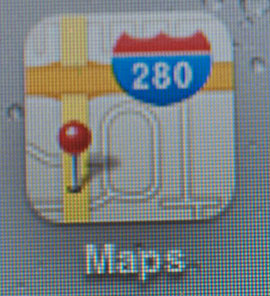 |
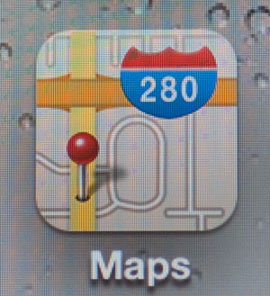 |
|
iPhone 3GS
|
iPhone 4
|

Text on the Google Nexus One

Text on the iPhone 4
The dot pitch is truly remarkable, so much so that Apple makes the claim that their display outresolves the human eye; its advertised ability to do so has earned it a new Apple tradename, "retina display."
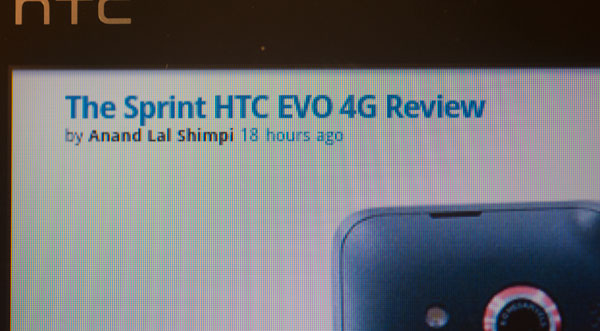
Text on the HTC EVO 4
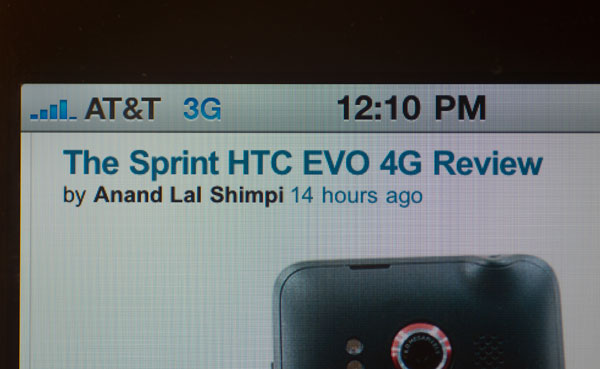
Text on the iPhone 4

AnandTech Logo on the EVO 4G

AnandTech Logo on the iPhone 4
Immediately after hearing Apple's claim that the Retina Display outresolves the human eye, I snapped into optics mode and crunched the numbers, and tweeted that the results were valid.
In the days that followed, there was considerable debate about the validity of Apple's claims. However, nearly all of the debate really just hinged on a debate over angular resolution of the human eye, and a little more over viewing distance. They're both entirely conventions.
As you've probably discovered by now, the human eye resolution can really only be characterized in angular subtense. Hold something closer to your eye, and you can see smaller features better (in theory), move it further away, and you can't make out small spatial details. The minimum angle visible with the human eye is the angle at which features (for the most common definition, a black and white square wave) stop being visible, and are indistinguishable from each other.
Most measures of visual acuity test with this implicitly - the Snellen eye chart's use of the capital "E" is literally a perfect example, which has given rise to a "tumbling E" eye chart. At twenty feet, the capital E subtends 5 minutes of arc, and conveniently has five half cycles of white to black (from top to bottom). So 20/20 implicitly implies an angular resolution of 1 arcminute (1/60 degrees).
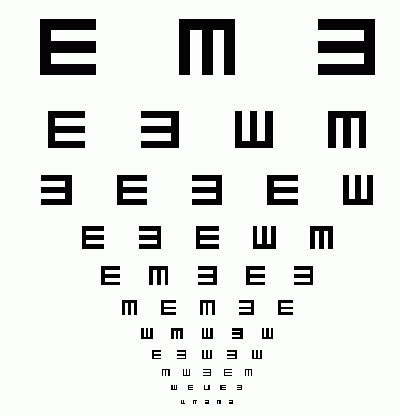
As an Optical Sciences and Engineering undergrad, I've had 1 arcminute drilled into my head more times than I can count as being the "normal" angular resolution of the human eye system. In practice, this is 20/20 vision, which is "normal," yet not perhaps the absolute maximum for human perfection. We can play games of course and argue that a small subset of the population has better than normal uncorrected vision, and thus an angular resolution of below 1 arcminute. I have above average uncorrected vision, which I've measured to be 20/15 on average, giving an angular resolution of approximately 0.75 arcminutes. Of course, the definitions stem from the spacing of cones in the fovea, the highest resolution part of the retina.
The other informational quantity needed to test the Retina Display claims is viewing distance. Again, there's a commonly agreed upon convention - standard viewing distance is considered to be 1 foot. This is another drilled into my brain number tossed around for comfortable viewing and reading. In practice, you can focus on objects much closer to your eye - this is called the near point and is often given as 10 inches, though as you get closer you increase strain aren't likely to keep it here.

Maybe not exactly the limit, but close enough.
Given the two most common standards tossed around, 1 arcminute and 12 inches, do the math out and you'll arrive at around 286 pixels per inch as the limit for eye resolving power, comfortably below the 326 on the Retina Display. Move to 0.75 arcminutes at 12 inches, and it's 382 pixels per inch, higher than the Retina Display. Honestly, I can't see the pixels at 12 inches.
Of course, the real story is even more complicated. Remember how the definition comes with the implicit assumption that we're dealing with a square wave pattern from white to black? That's a factor too - the contrast of the two pixels. Lower the contrast, and the eye's ability to pick out features decreases even more. So far, everything we've talked about has been first order, and without aberrations. Toss in spherical and astigmatism, two aberrations common to the eye system, and eye performance drops way more.
The human eye system is actually pretty poor, and shockingly easy to outresolve. In fact, if you saw the image your eye forms on your retina, you'd likely be appalled; it's your brain that makes the system usable. But at the end of the day, Apple's claims that the display outresolves the human eye are good enough for us.










270 Comments
View All Comments
Anand Lal Shimpi - Wednesday, June 30, 2010 - link
It honestly is basic differences in UI design. Unified settings panels (iOS) vs. per-app options and global settings (Android), much more freedom to configure how you want things displayed/presented, extending all the way down to the keyboard (Android) vs. a single Apple dictated way. These are the types of things that make the iPhone more of an appliance, basically if you like Apple's approach then there's no better device for you. A *lot* of users don't, and that's where Android comes in to play. I don't believe the power and flexibility of a PC-like device is a bad thing, but not everyone feels the same way. Take a die hard iPhone user and give them your Droid, you'll probably get the same response I did when I let some of those folks use the Nexus One or EVO 4G. It's really a preference thing, it reminds me a lot of the Mac vs. PC debates.And while i haven't played with the Droid, the scrolling issue is present on the Nexus One with live wallpapers disabled as well as enabled. Although enabling them makes it worse. The HTC Incredible is the first Android phone I've used that actually improved it, although didn't solve it completely.
I expect that in the next major Android update Google will fix it once and for all. I hope.
Take care,
Anand
JAS - Wednesday, June 30, 2010 - link
Yes, "more open, more configurable" is a double-edged sword. A comparison of Microsoft Windows and Macintosh OS X is apt in this regard.P.S. -- Can we advance beyond the juvenile label of "fanboy" when criticizing a person's like for a product?
bplewis24 - Wednesday, June 30, 2010 - link
Juvenile comes with the intent. I have the utmost respect for Anand and his opinion/reviews. If you take "fanboy" as a disparaging remark, fine, but it essentially means you have a bias or preference that obscures some of your objectivity.Brandon
The0ne - Wednesday, June 30, 2010 - link
As I've often expressed here, I like the reviews to not have any 1st person views. I don't care if one waited for 6hours for a phone. I don't want to hear any "this phone is the all to be". I just want a detail review of the phone and it's features. If one can qualify and/or quantify the differences with other products great. If you can't then don't, rather then having the innate urge to add your own opinions.Yes, the apple UI is more smooth, the experience is more enjoyable. The druid UI is a tad slower but by no means going to destroy or ruin anyone's experience. If you can't justify it, don't!
Lastly, the problem with 1st person perspectives being included in reviews and especially technical reports is that the reader will see it as favoritism. This is why absolutely NO credible technical and scientific review/report is written this way. I don't write my engineering tests and reports in 1st person. Just stick to the material and leave opinions out of it. This type of review ONLY happens online and sadly it's affecting technical and scientific materials as well.
Do the job, state the facts and tests and let the reader decide how to deal with it. Don't offer the reader any types of suggestion or persuasive comments. If you do include it, like other websites, in the editorial section or something similar.
kmmatney - Wednesday, June 30, 2010 - link
I wouldn't want to read reviews that just state facts. I'm an engineer/scientist and have written many peer-reviewed scientific papers. For tech reviews, though, I really appreciate user experience. There are just too many intangibles that can't be expressed by facts and tests. That's why I have been reading Anadtech for over 11 years - I appreciate the blend of techiness and user experience.totenkopf - Wednesday, June 30, 2010 - link
I have to agree with TheOne on this. Also, you can express "intangibles" without using the first person... If the iPhone's UI feels smoother than another phone then just say that and leave off the "I feel" bit.Remember that any statement comparing the iPhone to "Android" will have its flaws. You can only compare the iPhone 4 to other phones, not android. Any such statement will inherently be some form of generalization. Besides, Comparisons made with particular Android phones will be far more helpful as many android phones offer an experience distinct form any other Android phone.
It's really not that uncommon for iPhone users to play with an Android phone and really like it. Many of them actually seem quite surprised that they actually like it; some merely think that iOS is the only show in town as it has been the best for a long time. Widgets, in particular, offer a lot of customization and, perhaps just as importantly, personalization, that many iPhone users seem to appreciate. If used correctly, widgets can multiply the functionality of your phone many times over, and in some cases preclude running many apps at all. That said, setting up an android with just the way you like it and hunting down the newest and best apps and widgets can be an ongoing struggle. However, many people will enjoy it immensely if for no other reason than to make their phone that much better in their own eyes.
There! My experience with android without sounding too biased... I think ;) It certainly sounds better than "Android rulz 'cus widgets are soo good and apple doesn't even have them because apple is fail!"
John Sawyer - Thursday, July 1, 2010 - link
As an iPhone user for the past year, I can concur with your observation that many iPhone users would be impressed with the latest Android phones. I've tried the Evo for about ten minutes, and during that time, I did some web browsing, ran some apps, etc., and it was fast (even with a 3G connection), seemed polished, and I wouldn't complain too much if it was the only phone I had to use. If I had the chance to use it longer, I might start seeing its deficiencies, but a quick look, looked good.Though a week later, the iPhone 4 was released, and I was blown away by its display, which no other phone matches yet, though I'm somewhat biased about that since I like to be able to read tiny text.
The0ne - Thursday, July 1, 2010 - link
The problem with user experience is that it's just that and it affects how readers perceive the product. I don't mind really that reviews are done this way, but many are done extremely bad. Here are a few examples of comments people include in their reviews..."I let me wife play with it for a day or so and she loves it!" This is quite common for PMP player reviews.
"This is the best thing ever to come out on a phone..." Best thing is more or less an exaggeration. Way too many improper adjectives are used in reviews. Anandtech is no exception to this.
"I like it..." Okay, that means what, I should too?
strikeback03 - Thursday, July 1, 2010 - link
I disagree, in that I think the subjective "feel" of one phone (and OS) relative to another is largely subjective and can't be quantified in just plain numbers. Would you really feel better if he stated that "after observation with a high speed camera phone X illustrates a scroll with 5 frames and phone Y does so with 20" as opposed to "phone X is noticeably choppier"? Or say for example Sprint shipped a special edition EVO with 768MB RAM, we know that is 50% more, but would it actually make a difference in your interaction with the phone if you had less than 20 apps open?I have an HTC Touch Diamond, a WM 6.1 phone with TouchFlo 3d. None of the reviews I read before purchase adequately described how clunky the interaction between the TouchFlo plugin and the background OS is, or how poorly optimized WM6.1 is for a touchscreen, and certainly not how the speed of the device goes from marginal when new to completely unacceptable after a few months and requires a hard reset to restore.
ipredroid - Saturday, July 3, 2010 - link
What many fail to realize is with out opinion there would only be numbers and no reason to have site with user friendly technical data (a site like this). Everyone's opinion is biased or influenced by something, simply sticky by facts and zero emotion devoted towards every product is impossible. Many opinions itself is laced in bias preference for facts.I for one want as much information as possible not half the information.
Facts and opinions have and always will be better than just one of them. Would you rather have technical data about someones trip to Mt. Everest or an opinion. I would want both, so would everyone else or else you are missing facts.
Science and opinion go hand in hand. Cause and effect.